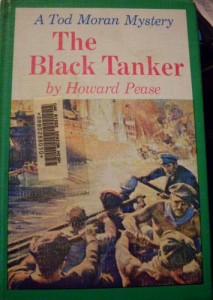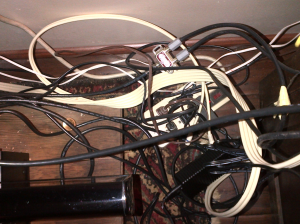Of course I can’t blame Comcast that I find it a challenge to buckle down and write. If it wasn’t Comcast, it would be the leak under my kitchen sink, or the incessant barking of my dogs, or any number of things that rudely insert themselves into my life and shatter what begins as a smooth, unbroken sheet of time into a myriad of shards, never to be reassembled.
When I was 21, my Dad’s brother’s wife, my aunt, hired me to paint her kitchen.
Aunt C. was an established, visual artist. Her media were oil and printmaking. She and my uncle were the most unconventional people I knew. They lived close to the beach in LA and their home was overgrown with semi-tropical plants. They listened to jazz and their furniture was handmade in Mexico. They had one child, a daughter, M, three-years my senior. I liked hanging out with M. She recommended books I almost always enjoyed and she offered previews of my future; first in high school, then in college.
Dad and L and C had been housemates during their student years at UC Berkeley. C wasn’t Jewish; in fact her father wrote and published Christian Bible stories. She also refused to wear brassieres or girdles. Mother felt responsible to occasionally remind me of Aunt C’s peculiar religious and wardrobe choices; neither of which held much significance for me but undoubtedly contributed to the smog-like atmospherics when our families got together.
I was happy when Aunt C asked me to paint her kitchen. I liked her and needed the money. I’d just finished my junior year at Berkeley and, partly due to C’s influence, had changed my major from psychology to anthropology; one of the several academic fields in which C had considerable knowledge. The colors she chose for her kitchen were straight from the villages of central Mexico! Clear, strong, and vibrant. I’d never imagined colors like this inside a house. My family’s domestic palate consisted of “off-white” and “sunshine yellow.”
Aunt C. wrote the names of the colors I was to use on the walls and cabinets. Given the number of colors, we estimated that it would take me about a week to complete the project. She would be in her studio (behind the house) and if I had questions or needed anything I should, and this is the point, wait until she came out for lunch. We would have 30 minutes before she returned to her studio. When I was ready to leave for the day, I should. Leave! No “goodbyes.” Just leave. If I came early enough to catch her at breakfast, fine. Otherwise, I was to be about my work without disturbing her. No questions. No phone calls. No visitors.
At our lunches, we talked about my studies. My latest girlfriend. My family. When I finished the job, she told me she was happy with the work I’d done. I was, too. Amazed, in fact, when I saw how it all came to life. On that last day, I did a few touch-ups, we ate lunch, she paid me and I left.
Mom told me she thought Aunt C was selfish to lock herself away and forbid interruptions. Even my cousin, M, had to wait until C came out before she could announce that she was home from school. I suppose Aunt C was selfish. But she’d learned that the only way she could be a productive artist was to guard her time. Treasure it.
Fifty years later, I’m still struggling with what Aunt C taught me; still seeking the balance between my need for solitude and my need for connection and engagement.
When I get it sorted out, I’ll let you know!




